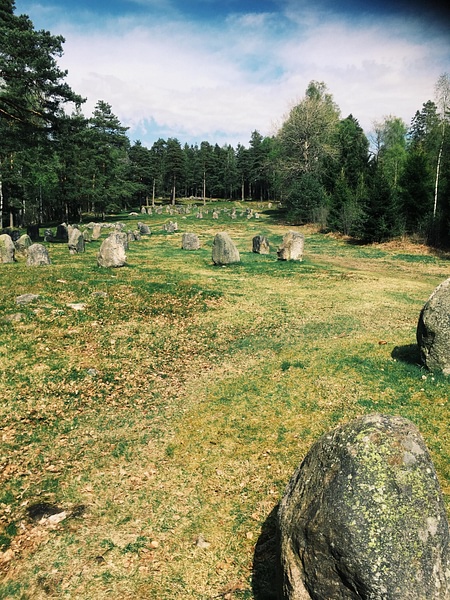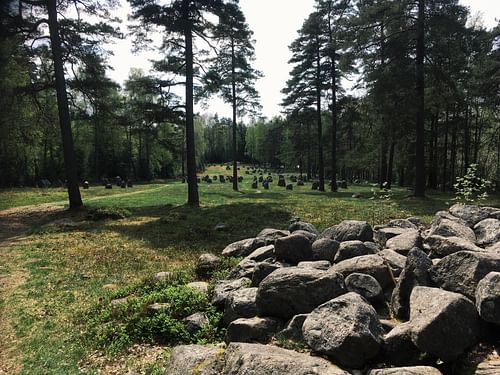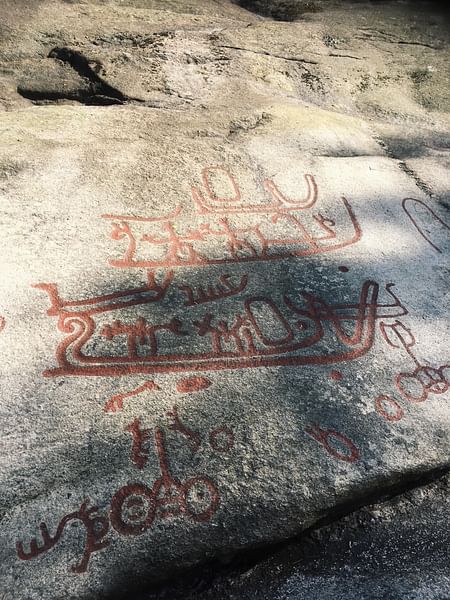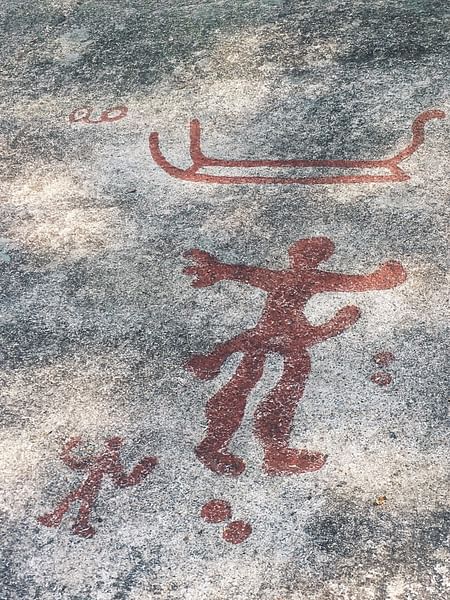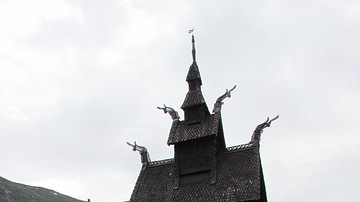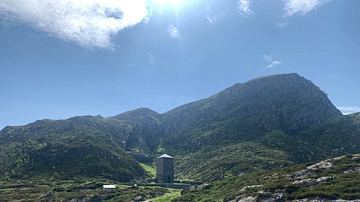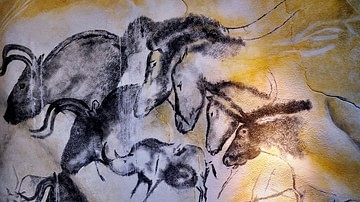Right outside the cities of Fredrikstad and Sarpsborg in South-East Norway, there are two archaeological, intriguing and beautiful sites, the Hunnfelt, a monument consisting of several stone circles and burial sites, and the Begbyfelt, a large collection of petroglyphs. The sites are encoded with a rich and still not fully understood history stretching from the early Bronze Age (1700-1100 BCE.) to the Viking Age (790-1100 CE).
South-East Norway and the county called “Østfold” is not especially famous for its historical value in Norway. Nor is Norway in any way as aware of its pre-historic monuments, stone circles, and other stone structures as, for example, Great Britain. There is great interest for sites such as Stonehenge (England) and The Standing Stones of Stenness (Scotland) both locally and internationally, with thousands of tourists visiting every year but very few travel to explore the Hunnfelt, Begbyfelt and similar sites in Norway. Even parts of the local population are in the dark about their region's hidden treasures. But that does not mean there is not a lot to explore. In fact, Østfold is the county in Norway with the largest number of petroglyphs from the Bronze Age (1700-500 BCE), and the region contains the most concentrated historical monuments from both the Bronze Age and Early Iron Age (500 BCE- 500CE) in Norway.
The Hunnfelt
After a little bit over an hour's ride from Oslo, as you drive onto a narrow and bumpy road and park at an abandoned parking lot in between a field and a forest, you would never anticipate what awaits you right behind the trees. Nothing suggests to you an entrance to a site of historical importance.
However, after only a few steps into the woods a large clearing opens up and nine stone circles become visible as they wind up a slight slope. The stone circles at Hunn are not as monumentally impressive as larger stone circles such as Stonehenge, but the site is in many ways equally mysterious as no one is completely sure what they were used for. The whole Hunnfelt is known as a burial site as it also contains several burial mounds, dating mostly from Pre-Roman (500 BCE) to the Late Iron Age (550-1050 CE), but it is not clear if the circles were a part of the burial site or if they were used for some other purpose. Due to the fact that the locals for a long time have named the site “Tingstedet”, translating to “the place of the law”, it has been thought that the site was used as a place for legal judgment or law-making. However, the archaeological finds of the burial sites have weakened this theory. Today it is more commonly thought that the circles were just a part of the burial complex or that it was a ceremonial site for pagan worship, possibly linked to burial, the celebration of seasons or one or more of the Norse gods and goddesses. The reason for the stone circle monument's longitudinal alignment along a North-South axis is also unknown.
Entering the clearing and just standing there for a few moments to admire the beautiful monument and breathe in the fresh Norwegian air leaves you feeling peaceful, but still curious as to what the site was originally used for by its ancient builders. At the site, you are free to walk wherever you like, or you can follow the trails through the different circles to the top of the slope where there are several bigger mounds. The stones in the standing circles vary in height as some reach up to the hip, while others almost to the shoulders. Most of the circles consist of 12, 13 or 15 individual stones.
You can sit down in the grass or on one of the stones in the mounds and just enjoy the beautiful view of the site and surrounding nature or you can walk over to one of the information boards that have been placed in different spots around the site to provide more detailed information about the mounds and circles, and also the archaeological excavations conducted at the site. The area had been known for a long time before the first excavation was conducted in 1894 CE. After the first excavation, several other unofficial excavations took place. A systematic excavation was conducted between 1950 and 1953 CE, involving many international archaeologists. During this work, rich finds were discovered in the burial mounds spanning from Late- Roman times to the Viking Age, as well as residence and agricultural residues from the late Stone Age (4000-1700 BCE) and Bronze Age. Later, it was also established that the oldest burial mounds date from the Bronze Age. There are even more of these mounds and circles if you continue to walk further into the forest around the clearing with the main stone circles. The Hunnfelt is really a unique site with an enchanting atmosphere, where you can spend hours learning and exploring while surrounded by beautiful nature.
The Begbyfelt
Approximately a five-minute drive from the parking lot at the Hunnfelt is the Begbyfelt. Like the Hunnfelt, the Begbyfelt is quite a large area filled with trees and other vegetation, and if you did not know the site's historical value you probably would have just driven by possibly noticing the green, beautiful nature and thinking this would be a nice place to go for a hike. But this site has so much more to offer than “just” beautiful nature as the area contains a large number of symbols and drawings cut in stone on large bare stone surfaces called “svaberg” which were made thousands of years ago. The petroglyphs at Begby are categorized as “Jordbruksristninger /Agricultural carvings” and are believed to have been made between c. 1800 BCE and c. 400 CE.
The Begby petroglyphs were painted red in later times (which in its time caused some controversy) so that the modern visitors are able to see and enjoy them. However, even though the stone carvings are visible, it does not mean their meaning and symbolic value is equally clear. The carvings depict different variations of ships, humans, wagons, and symbols. Although some of the carvings are easier to make out, for example, the ships, it is not clear what stories they try to tell. The many symbols of different character are even more mysterious as their meaning is still unknown, though some believe them to be linked to the sun and/or fertility worship. Because of this, the petroglyphs have been important in trying to figure out the myths and ceremonies connected to agriculture, harvest and fertility in ancient Norway. Another mystery surrounding the carvings is how they were made. Archaeologists have not yet been able to discover what types of tools were used by the ancient inhabitants of Østfold to create this magnificent stone art.
The petroglyphs are visible in two main areas; Gullskår and Skolefeltet. On the sites, there are constructed platforms to stand on, both to protect the rock art and for the visitor to get a better view. Similar to the Hunnfelt, there are also information boards on several of the platforms with details about the site, specific carvings and the conservation work. A trail has been constructed through the area connecting the sites, which makes sure you will see all the notable carvings. The trail also takes you through a beautiful forest and pastures where, if you are lucky, you can meet a couple of grazing sheep. In this area, you can also discover a burial site with a visible burial mound. The burial mound dates from the Iron Age (500 BCE - 1030 CE) and the relics of a woman were found here. Only people of importance and high social status were buried in these elaborate burial structures, showing how women of this era played an important part in society, possibly more equal to men than their successors in the Viking Age and the time after the introduction of Christianity.
Getting there
The benefit of the sites' lack of fame is that you will most likely be able to explore them almost or completely alone. In contrast to other ancient sites of more national and international interest, you do not have to wait in line, follow a specific track or struggle to get a good picture of the site without interference from other visitors. If you want you can sit down in the middle of one of the circles and eat lunch, draw or write notes, or you can stand up and dance - without bothering anyone. Also, you do not have to pay anything to experience the sites, as they are open-air cultural landscapes, which also means you can come and go whenever you like. In addition, to learn more about the mysterious history of ancient Norway and the Østfold region, the bonus of traveling to these “forgotten” historical sites is that it makes you feel more like an explorer than a tourist.
To visit the sites it is most practical to rent or borrow a car in Oslo and go for a day trip, the drive being approximately 1 hour and 20 minutes from Oslo. From the capital, you take the E6 road towards Gothenburg (Sweden), until you reach the Solberg crossing. There you drive onto road 110 towards Fredrikstad and when you reach Skivika look for the sign leading you to the parking lot for the Hunnfelt. Alternatively, it is recommended to stay overnight in Fredrikstad, where you can also explore the old city from the 16th and 17th century CE, which is Scandinavia's best preserved fortified town. There are also more sites worth visiting if you have time on what is called “Oldtidsveien” (“The Ancient Trail"-the collection of historical sites outside Fredrikstad), for example, the petroglyph named Bjørnstadskipet. All the sites are beautiful all year round, but it is recommended to visit during spring or summer, as especially the petroglyphs are more visible. It also brings even more enchantment to the sites to visit in the spring, when nature is reborn, reminding the visitor how the people using and living at the sites hundreds and thousands of years ago lived more in tune with nature and had more contact with its seasonal cycles.

